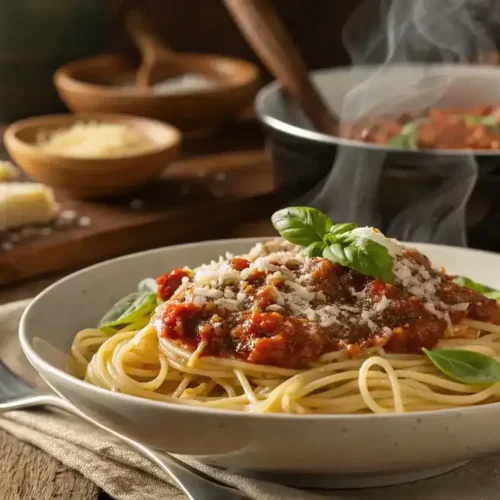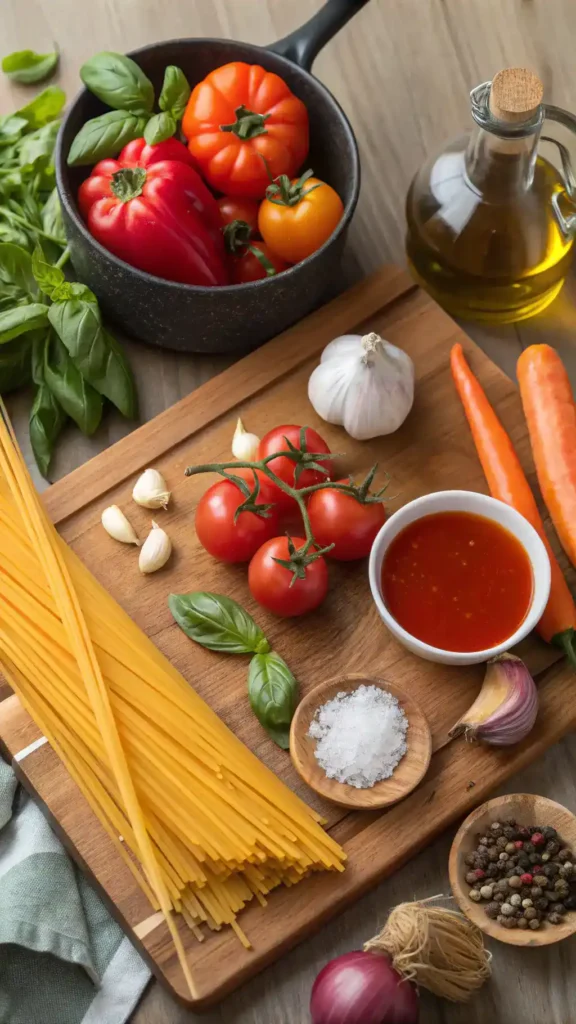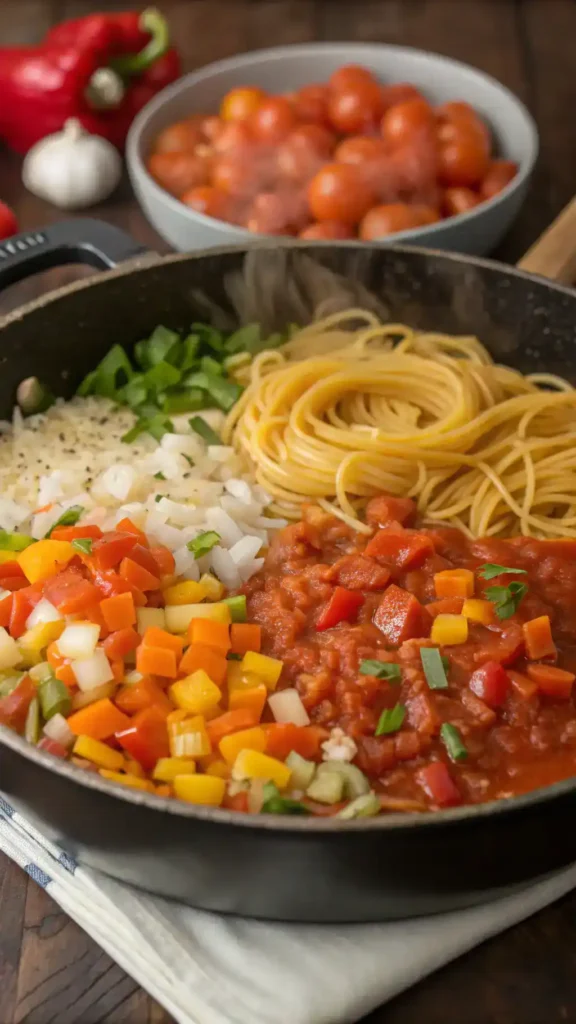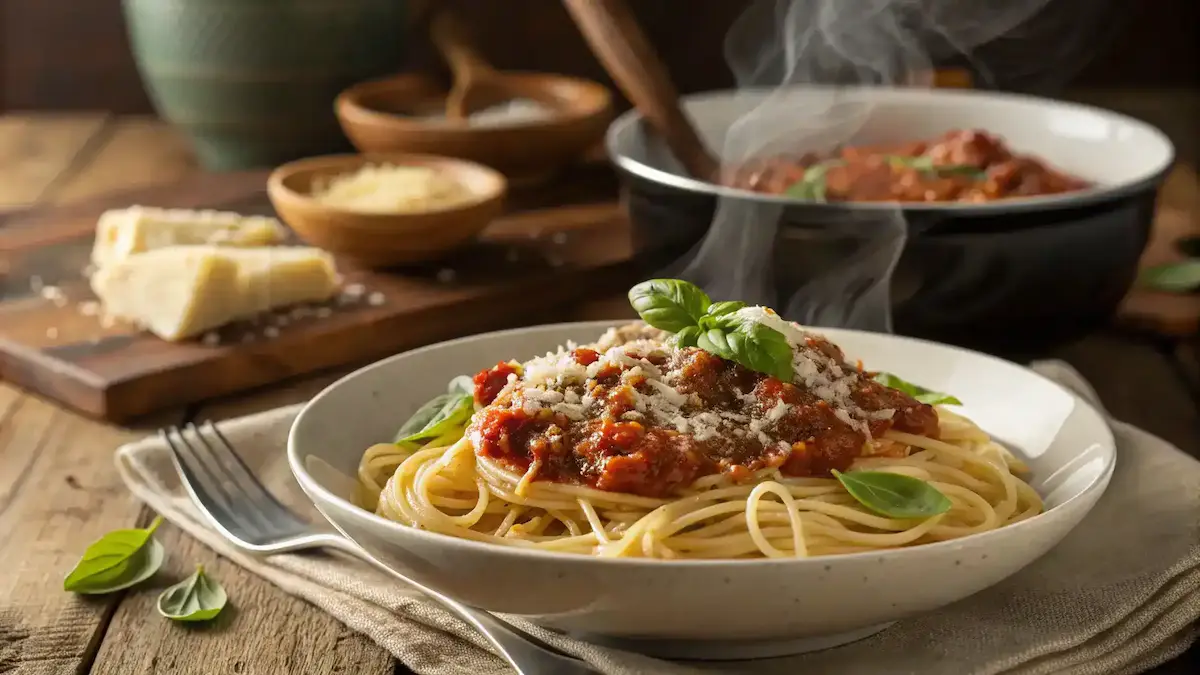Imagine the rich aroma of tomatoes and herbs wafting through your kitchen, inviting everyone to gather around the table. This Homemade Spaghetti Sauce Recipe is not only a delightful way to elevate your pasta dishes, but it also brings a wealth of health benefits. By using fresh ingredients, you can create a sauce that is both nutritious and bursting with flavor. Moreover, it’s incredibly easy to prepare, making it a perfect choice for busy weeknights or family gatherings. Whether you’re a seasoned cook or just starting out, this recipe will guide you through the process of crafting a delicious sauce that everyone will love. So, let’s dive into the world of homemade goodness and discover how to make a spaghetti sauce that will leave your taste buds dancing!
Table of Contents

Spaghetti Sauce Recipe
Equipment
- 1 Large Skillet For sautéing the ingredients.
Ingredients
Fresh Ingredients
- 4 cups Diced Fresh Tomatoes Or 2 cans of crushed tomatoes.
- 3 cloves Garlic Minced.
- 1 medium Onion Chopped.
Herbs and Spices
- 2 tablespoons Olive Oil For sautéing.
- 1 teaspoon Dried Oregano For seasoning.
- 1 teaspoon Dried Basil For seasoning.
- 1 medium Bell Pepper Diced.
- 1 medium Carrot Grated.
- 1 teaspoon Sugar To balance acidity.
- to taste Salt and Pepper For seasoning.
- splash Vegetable Broth To adjust consistency.
Instructions
Preparation
- Start by gathering all your ingredients. You will need fresh tomatoes (or canned), garlic, onions, olive oil, basil, oregano, bell peppers, and carrots. Having everything ready makes the cooking process smoother.
Sautéing Aromatics
- In a large skillet, heat 2 tablespoons of olive oil over medium heat. Add 1 chopped onion and 3 minced garlic cloves. Sauté them for about 3-4 minutes, or until the onions become translucent and fragrant.
Adding Vegetables
- Incorporate 1 diced bell pepper and 1 grated carrot into the skillet. Stir them in and cook for another 5 minutes.
Incorporating Tomatoes
- Add 4 cups of diced fresh tomatoes (or 2 cans of crushed tomatoes) to the skillet. Stir everything together.
Seasoning the Sauce
- Sprinkle in 1 teaspoon of dried oregano, 1 teaspoon of dried basil, and a pinch of salt and pepper. If the sauce is too acidic, add a teaspoon of sugar. Stir well to combine.
Simmering
- Reduce the heat to low and let the sauce simmer uncovered for at least 30 minutes. Stir occasionally to prevent sticking.
Adjusting Consistency
- If the sauce becomes too thick, add a splash of vegetable broth or water. If it’s too thin, let it simmer longer.
Final Taste Adjustment
- Taste your sauce and adjust the seasoning if necessary. This is your chance to make it just right!
Video
Notes
| Calories | Fat | Protein | Carbs |
|---|---|---|---|
| 150 | 7g | 3g | 20g |
Key Benefits
This homemade spaghetti sauce recipe not only enhances the flavor of your pasta dishes but also offers numerous health benefits. By using fresh ingredients, you can enjoy a nutritious meal that’s easy to prepare and budget-friendly, making it perfect for families and individuals alike. Here are some key benefits of this delightful recipe:
- Nutritional Value: Packed with vitamins and antioxidants, this sauce is a great way to incorporate more vegetables into your diet. Tomatoes, for instance, are rich in lycopene, which is known for its heart health benefits. Learn more about tomatoes and the antioxidant lycopene.
- Homemade Goodness: When you make your own spaghetti sauce, you control the ingredients. This means no preservatives or artificial flavors, just pure, wholesome goodness.
- Flavor Enhancement: Fresh herbs like basil and oregano elevate the taste of your sauce, providing a depth of flavor that store-bought options often lack.
- Cost-Effective: Making spaghetti sauce at home is not only economical but also allows you to use seasonal produce, which can save you money while maximizing flavor.
- Easy Meal Prep: This recipe is straightforward and can be made in bulk. You can prepare a large batch and freeze portions for quick meals later, making weeknight dinners a breeze.
- Health-Conscious: By using olive oil instead of butter and opting for fresh vegetables, you create a healthier sauce that aligns with various dietary preferences.
- Family-Friendly: This spaghetti sauce is versatile and can be enjoyed by everyone. Whether served over pasta, used in lasagna, or as a dipping sauce, it caters to different tastes and preferences.
In summary, this spaghetti sauce recipe is not just about satisfying your hunger; it’s about nourishing your body and creating memorable meals with loved ones. So, gather your ingredients and enjoy the process of making a delicious, homemade spaghetti sauce that everyone will love!
Ingredients
To create a rich and flavorful spaghetti sauce, gather the following ingredients:
- Fresh Tomatoes: Ripe tomatoes are packed with vitamins C and K, as well as antioxidants that support heart health.
- Garlic: This aromatic bulb not only adds depth to your sauce but also boasts anti-inflammatory properties.
- Onions: Sweet onions provide natural sweetness and are rich in quercetin, which may help reduce blood pressure.
- Olive Oil: A heart-healthy fat, olive oil is loaded with monounsaturated fats and antioxidants.
- Basil: This fragrant herb enhances flavor while offering anti-inflammatory benefits.
- Oregano: Known for its antibacterial properties, oregano adds a robust flavor to your sauce.
- Bell Peppers: These colorful veggies are high in vitamins A and C, contributing to your overall health.
- Carrot: Adding a touch of sweetness, carrots are rich in beta-carotene, which is great for your vision.
- Sugar: A pinch of sugar balances the acidity of the tomatoes, enhancing the overall flavor.
- Salt and Pepper: Essential for seasoning, these spices elevate the taste of your sauce.
- Vegetable Broth: This adds depth and richness, while being low in calories and fat.

By using these fresh ingredients, you not only create a delicious spaghetti sauce recipe but also ensure that your meal is health-conscious and satisfying. Remember, the quality of your ingredients can significantly impact the flavor, so opt for the freshest produce available. Enjoy the process of crafting your homemade spaghetti sauce, and feel good about serving a nutritious meal to your family!
How to Make Spaghetti Sauce Recipe
Making a delicious spaghetti sauce is easier than you might think! Follow these simple steps to create a rich and flavorful sauce that will elevate your pasta dishes.
- Prepare Your Ingredients: Start by gathering all your ingredients. You will need fresh tomatoes (or canned), garlic, onions, olive oil, basil, oregano, bell peppers, and carrots. Having everything ready makes the cooking process smoother.
- Sauté the Aromatics: In a large skillet, heat 2 tablespoons of olive oil over medium heat. Add 1 chopped onion and 3 minced garlic cloves. Sauté them for about 3-4 minutes, or until the onions become translucent and fragrant. This step builds the foundation of flavor for your spaghetti sauce.
- Add the Vegetables: Next, incorporate 1 diced bell pepper and 1 grated carrot into the skillet. Stir them in and cook for another 5 minutes. The sweetness from the carrot and bell pepper enhances the sauce’s overall taste.
- Incorporate the Tomatoes: Now, add 4 cups of diced fresh tomatoes (or 2 cans of crushed tomatoes) to the skillet. Stir everything together, allowing the tomatoes to mingle with the sautéed vegetables.
- Season the Sauce: Sprinkle in 1 teaspoon of dried oregano, 1 teaspoon of dried basil, and a pinch of salt and pepper. If you find the sauce too acidic, add a teaspoon of sugar to balance the flavors. Stir well to combine.
- Simmer for Flavor Development: Reduce the heat to low and let the sauce simmer uncovered for at least 30 minutes. Stir occasionally to prevent sticking. This simmering time is crucial for developing the rich flavors of your spaghetti sauce.
- Adjust Consistency: If the sauce becomes too thick, you can add a splash of vegetable broth or water to reach your desired consistency. Conversely, if it’s too thin, let it simmer a bit longer.
- Taste and Adjust: Before serving, taste your sauce and adjust the seasoning if necessary. You might want to add more herbs or a bit more salt. This is your chance to make it just right!

And there you have it! Your homemade spaghetti sauce is ready to be served. Enjoy it over your favorite pasta, and don’t forget to share it with family and friends!
Pro Tips, Variations & Common Problems
Creating the perfect spaghetti sauce can be a delightful journey. Here are some pro tips and variations to elevate your Spaghetti Sauce Recipe, along with solutions to common problems you might encounter.
Pro Tips
– For a richer flavor, sauté your onions and garlic until they are golden brown. This caramelization adds depth to your sauce.
– If you prefer a smoother texture, consider blending the sauce with an immersion blender after simmering. This step is optional, but it can create a velvety finish.
– Always taste your sauce as it cooks. Adjust the seasoning gradually, adding salt and pepper to enhance the flavors.
– To deepen the flavor, add a splash of vegetable broth during cooking. This addition can make a significant difference.
Ingredient Variations
– If you want to experiment, try adding different vegetables like zucchini or mushrooms. These can provide extra nutrients and flavor.
– For a spicy kick, incorporate red pepper flakes or diced jalapeños. This variation is perfect for those who enjoy a bit of heat.
– You can also swap out fresh herbs for dried ones. Generally, use one-third the amount of dried herbs compared to fresh, as dried herbs are more concentrated.
– If you’re looking for a protein boost, consider adding ground turkey or plant-based meat alternatives. This change can make your sauce heartier.
Common Problems & Solutions
– If your sauce turns out too acidic, don’t worry! Simply add a pinch of sugar to balance the flavors. This trick works wonders.
– Should your sauce be too thick, thin it out with a bit of vegetable broth or water. Stir it in gradually until you reach your desired consistency.
– Conversely, if your sauce is too thin, let it simmer uncovered for a bit longer. This method allows excess moisture to evaporate, thickening the sauce.
– Lastly, if you find your sauce lacking in flavor, consider adding a splash of balsamic vinegar or a squeeze of lemon juice. These additions can brighten the overall taste.
With these tips and variations, your Spaghetti Sauce Recipe will surely impress family and friends. Enjoy the process, and don’t hesitate to make it your own!
Serving Suggestions for Your Spaghetti Sauce Recipe
When it comes to enjoying your homemade spaghetti sauce, the possibilities are endless! This delightful sauce is perfect for various occasions, making it a versatile choice for any meal. Here are some engaging serving suggestions that will surely impress your guests:
- Family Dinners: Serve your spaghetti sauce over al dente spaghetti or penne for a classic family meal. Pair it with a side of garlic bread and a fresh garden salad to create a comforting dinner experience.
- Casual Gatherings: For a laid-back get-together, consider setting up a pasta bar. Offer different pasta shapes and toppings, such as grated Parmesan, fresh basil, and crushed red pepper flakes. This interactive approach allows guests to customize their plates, making it a fun and engaging dining experience.
- Romantic Evenings: If you’re planning a cozy dinner for two, serve your spaghetti sauce with a side of roasted vegetables and a glass of sparkling water with lemon. The vibrant colors and flavors will create an inviting atmosphere, perfect for a romantic evening.
- Potluck Parties: Your homemade spaghetti sauce is an excellent choice for potlucks. Bring it in a slow cooker to keep it warm, and serve it alongside a variety of pasta options. This way, everyone can enjoy a hearty meal that feels like home.
- Meal Prep: For busy weekdays, prepare a large batch of spaghetti sauce and store it in individual containers. This makes for quick and easy lunches or dinners throughout the week. Simply heat it up and serve over your favorite pasta for a satisfying meal in minutes.
Additionally, don’t forget to garnish your spaghetti sauce with fresh herbs or a sprinkle of nutritional yeast for a vegan option. These small touches not only enhance the flavor but also add visual appeal to your dish. Overall, your homemade spaghetti sauce recipe is not just a meal; it’s an experience that brings people together. Enjoy every bite!
Preserving and Reheating Your Spaghetti Sauce Recipe
To ensure your homemade spaghetti sauce remains delicious and fresh, proper storage is essential. First, allow the sauce to cool completely before transferring it to airtight containers. This step is crucial because it prevents condensation, which can lead to spoilage. You can refrigerate your spaghetti sauce for up to one week. If you want to keep it longer, consider freezing it. In the freezer, your sauce can last for up to three months. For optimal freshness, use vacuum-sealing bags or freezer-safe containers. Additionally, label your containers with the date to keep track of their freshness. Remember, always check for signs of spoilage, such as off smells or discoloration, before using your sauce.
Reheating Methods
When it comes to reheating your spaghetti sauce, the stovetop is your best friend. Start by pouring the desired amount of sauce into a saucepan. Then, add a splash of water or vegetable broth to maintain moisture. Heat over medium-low heat, stirring occasionally. This method helps preserve the sauce’s flavor and texture. Alternatively, if you’re short on time, the microwave is a convenient option. Place the sauce in a microwave-safe bowl, cover it loosely, and heat in 30-second intervals, stirring in between. This technique ensures even heating without drying out the sauce. Lastly, if you prefer using an air fryer, set it to a low temperature and heat the sauce in an oven-safe dish, stirring occasionally to prevent sticking. Regardless of the method, always taste your sauce after reheating. If it seems a bit dry, simply add a touch more broth or water to refresh it.
Conclusion
In summary, this Homemade Spaghetti Sauce Recipe is a delightful blend of fresh ingredients and simple techniques that make it a standout choice for any home cook. Not only does it offer a burst of flavor, but it also allows for endless customization, ensuring that you can tailor it to your family’s tastes. So, whether you’re preparing a cozy dinner for yourself or a feast for loved ones, this recipe is sure to impress.
As you embark on this culinary adventure, I encourage you to share your results or ask any questions you may have. Cooking is all about exploration, and I would love to hear how your sauce turns out! Additionally, feel free to experiment with variations—perhaps adding a dash of red pepper flakes for heat or incorporating seasonal vegetables for a unique twist. Remember, the kitchen is your canvas, and this Spaghetti Sauce Recipe is an excellent opportunity to get creative.
Ultimately, cooking should be a joyful experience, and making your own spaghetti sauce is a wonderful way to connect with food and loved ones. So gather your ingredients, roll up your sleeves, and enjoy the process. Happy cooking!
FAQs about Spaghetti Sauce Recipe
Here are some common questions and answers to help you make the best homemade spaghetti sauce!
1. Can I use canned tomatoes instead of fresh ones?
Absolutely! Canned tomatoes are a great alternative, especially when fresh tomatoes are out of season. They are convenient and often packed at peak ripeness, ensuring a rich flavor in your spaghetti sauce recipe.
2. How can I make my spaghetti sauce less acidic?
If your sauce tastes too acidic, you can add a pinch of sugar to balance the flavors. Additionally, incorporating grated carrots can naturally sweeten the sauce without altering the taste significantly.
3. What herbs work best in spaghetti sauce?
Common herbs for spaghetti sauce include basil and oregano. However, you can also experiment with thyme or parsley for added depth. Fresh herbs should be added towards the end of cooking for the best flavor.
4. How long can I store homemade spaghetti sauce?
You can store your homemade spaghetti sauce in the refrigerator for up to a week. For longer storage, freeze it in airtight containers for up to three months. Just remember to let it cool completely before freezing!
5. Can I make this sauce vegan?
Yes, this spaghetti sauce recipe is naturally vegan! Just ensure that any additional ingredients, like pasta or cheese, are also plant-based. You can use nutritional yeast as a cheese substitute for a savory flavor.

